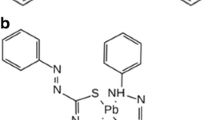Abstract
Biomonitoring of lead (Pb) in blood and urine enables quantitative evaluation of human occupational and environmental exposures to Pb. State-of-the-art ICP–MS instruments can only analyze metals in laboratories, resulting in lengthy turnaround times, and they are expensive. In response to the growing need for a metal analyzer capable of on-site, real-time monitoring of trace toxic metals in individuals, we developed a portable microanalyzer based on flow-injection/stripping voltammetry (ASV), and validated the system using rat blood and urine spiked with known amounts of Pb. Fouling of electrodes by proteins often prevents the effective use of electrochemical sensors in biological matrices. Minimization of such fouling was accomplished with suitable sample pretreatment and by establishing turbulent flow of blood and urine containing Pb onto the electrode inside the microanalyzer, which resulted in no apparent electrode fouling even when the samples contained 50% urine or 10% blood by volume. No matrix effect was observed for the voltammetric Pb signals, even when the samples contained 10% blood or 10% urine. The microanalyzer offered linear concentration ranges relevant to Pb exposure levels in humans (0–20 ppb in 10% blood samples, 0–50 ppb in 50% urine samples). The device showed excellent sensitivity and reproducibility; Pb detection limits were 0.44 ppb and 0.46 ppb, and % R.S.D. was 4.9 and 2.4 in 50% urine and 10% blood samples, respectively. It gave similar Pb concentrations in blood and urine to those measured by ICP–MS. It offered high throughput (3 min per sample) and economical use of samples (60 μL per measurement) as well as low reagent consumption (1 μg of Hg per measurement), thus minimizing environmental concerns associated with mercury use. Since it is miniaturized, the microanalyzer is portable and field-deployable. Thus, it shows much promise as the next-generation analyzer for the biomonitoring of toxic metals.



Similar content being viewed by others
References
Friberg L, Elinder CG (1993) J Work Environ Health 19(Suppl 1):7
Christensen JM (1995) Sci Total Environ 166:89
Juberg DR, Kleiman CF, Kwon SC (1997) Ecotox Environ Safe 38:162–180
National Academy of Sciences, Board on Environmental Studies and Toxicology, Commission on Life Sciences (1993) Measuring lead exposure in infants, children, and other sensitive populations. National Academy Press, Washington, DC
Gething J (1975) Br J Ind Med 32(4):329–333
Torres-Alanis O, Garza-Ocanas L, Pineyro-Lopez A (2002) Hum Exp Toxicol 21:573–577
Lin Y, Zhao R, Thrall KD, Timchalk C, Bennett WD, Matson MD (1999) Proc Soc Opt Eng (SPIE) 3877:248
Lin Y, Timchalk CA, Matson DW, Wu H, Thrall KD (2001) Biomed Microdev 3:331
Wang J (1994) Analytical electrochemistry. VCH, New York
Wang J, Lin Y, Chen L (1993) Analyst 118:277
Timchalk C, Poet TS, Lin Y, Weitz KK, Zhao R, Thrall KD (2001) J Am Ind Hyg Assoc 62:295–302
Wang J (1982) J Electroanal Chem 139:225
Bohs CE, Linhares MC, Kissinger PT (1994) Curr Sep 13:6
Kim DT, Blanch HW, Radke CJ (2002) Langmuir 18:5841
West CE, Hardcastle JL, Compton RG (2002) Electroanalysis 14:1470
Hardcastle JL, Compton RG (2002) Electroanalysis 14:753
Hardcastle JL, Murcott GG, Compton RG (2000) Electroanalysis 12:559
Hardcastle JL, West CE, Compton RG (2002) Analyst 127:1495
Liu TZ, Lai D, Osterloh JD (1997) Anal Chem 69:3539–3543
Yang C-C, Kumar AS, Zen J-M (2005) Anal Biochem 338:278–283
Zhou F, Aronson JT, Ruegnitz MW (1997) Anal Chem 69:728
Yantasee W, Timchalk C, Weitz KK, Moore DA, Lin Y (2005) Talanta 67:617–624
CDC (1999) MMWR 48:27–29
CDC (2000) MMRW 49:1133–1137
Markowitz M (2000) Curr Probl Pediatr 30:62–70
Banks CE, Compton RG (2004) Analyst 129:678
Schutz A, Bergdahl I, Ekholm A, Skerfving S (1996) Occup Environ Med 53:736–740
Roberts FJ, Ebdon L, Hill SJ (2000) J Trace Elem Med Biol 14:108–115
Agra-Gutierrez C, Compton RG (1998) Electroanalysis 10:603
Compton RG, Eklund JC, Marken F (1997) Electroanalysis 9:509
Acknowledgements
The work was supported by grant 1 R01 ES010976-01A2 from the National Institute of Environmental Health Sciences (NIEHS), NIH. Its contents are solely the responsibility of the authors and do not necessarily represent the official views of NIEHS. The research was performed in part at the Environmental Molecular Sciences Laboratory, a national scientific user facility sponsored by the DOE’s Office of Biological and Environmental Research and located at PNNL. PNNL is operated by Battelle for the U.S. DOE under Contract DE-AC05-76RL01830.
The authors thank Mr. Richard A. Gies for technical support in collecting urine and blood samples and Mr. Dean Moore for ICP-MS instrumentation.
Author information
Authors and Affiliations
Corresponding author
Rights and permissions
About this article
Cite this article
Yantasee, W., Timchalk, C. & Lin, Y. Microanalyzer for biomonitoring lead (Pb) in blood and urine. Anal Bioanal Chem 387, 335–341 (2007). https://doi.org/10.1007/s00216-006-0940-1
Received:
Revised:
Accepted:
Published:
Issue Date:
DOI: https://doi.org/10.1007/s00216-006-0940-1




